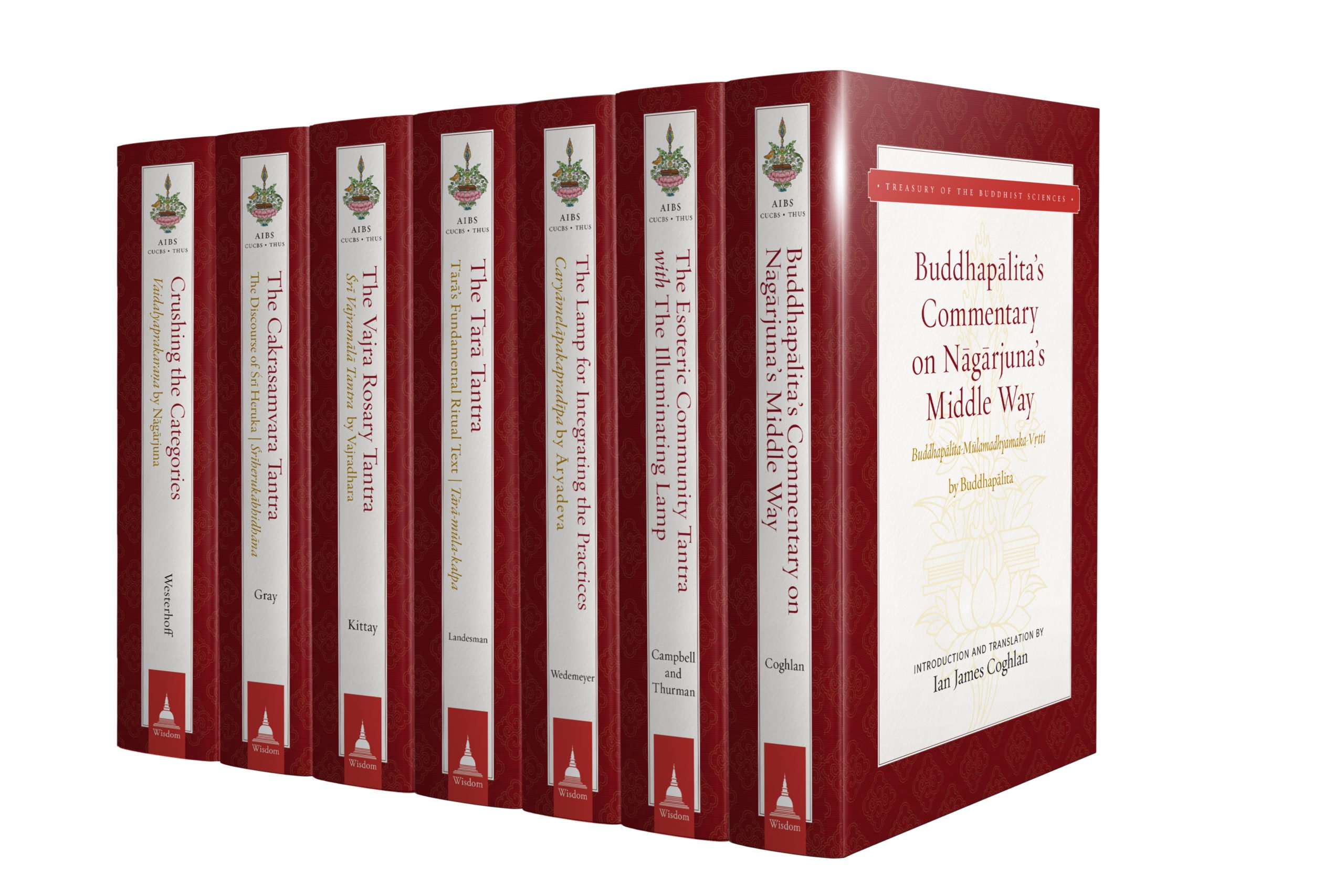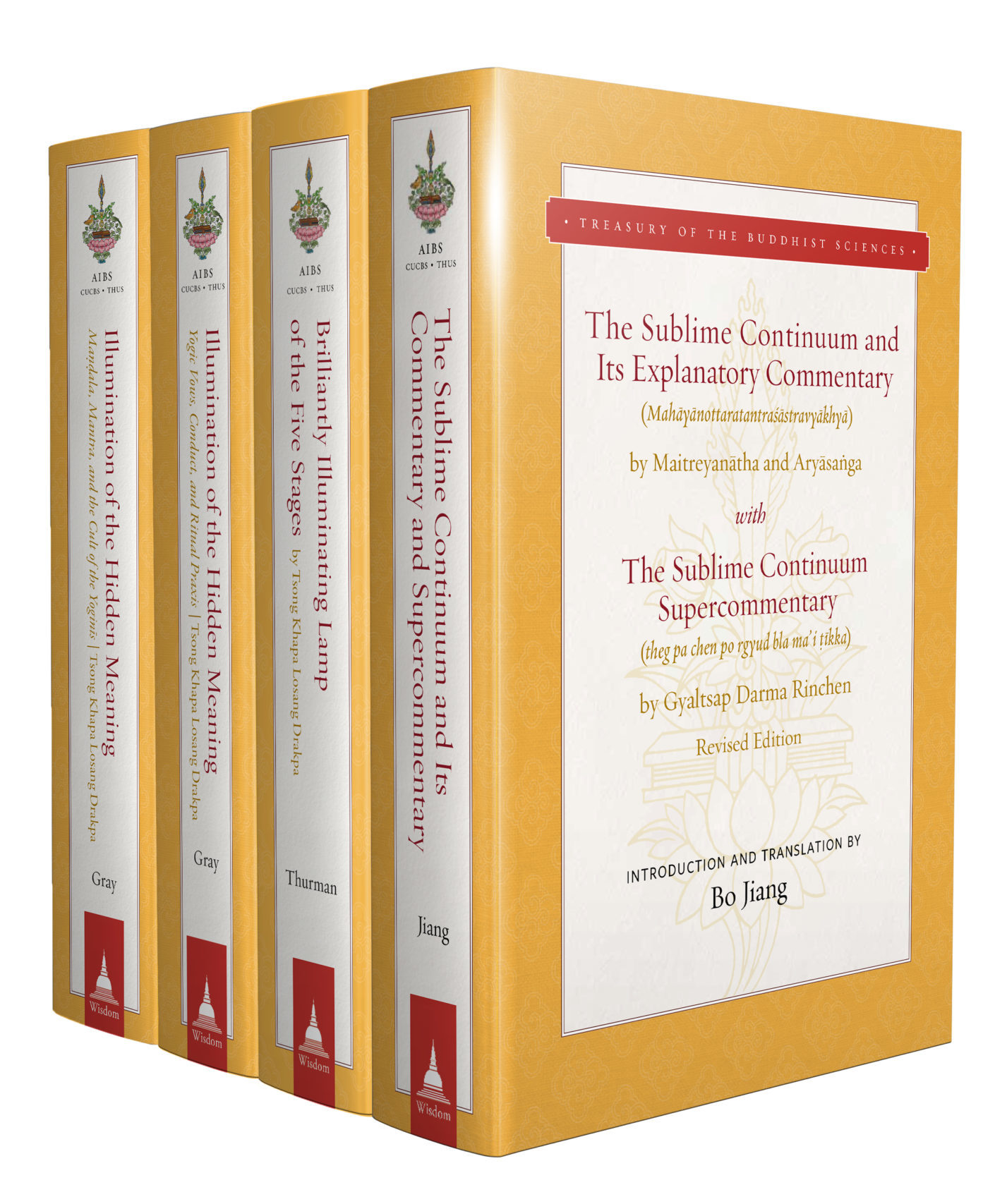
The American Institute of Buddhist Studies
Treasury of the Buddhist Sciences
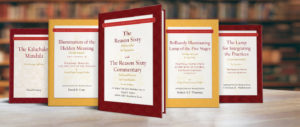 The Treasury of the Buddhist Sciences series is copublished by the American Institute of Buddhist Studies (AIBS) and Wisdom Publications in association with the Columbia University Center for Buddhist Studies and Tibet House US. AIBS established this series to provide authoritative translations, studies, and editions of the texts of the Tibetan Tengyur (bstan ’gyur) and its associated literature. The Tibetan Tengyur is a vast collection of over 4,000 classical Indian Buddhist scientific treatises (śāstra) written mostly in Sanskrit by over 700 authors from the first millennium CE, now preserved mainly in systematic 7th–12th century Tibetan translation. Its topics span all of India’s “outer” arts and sciences, including linguistics, medicine, astronomy, socio-political theory, ethics, art, and so on, as well as all of her “inner” arts and sciences such as philosophy, psychology (“mind science”), meditation, and yoga.
The Treasury of the Buddhist Sciences series is copublished by the American Institute of Buddhist Studies (AIBS) and Wisdom Publications in association with the Columbia University Center for Buddhist Studies and Tibet House US. AIBS established this series to provide authoritative translations, studies, and editions of the texts of the Tibetan Tengyur (bstan ’gyur) and its associated literature. The Tibetan Tengyur is a vast collection of over 4,000 classical Indian Buddhist scientific treatises (śāstra) written mostly in Sanskrit by over 700 authors from the first millennium CE, now preserved mainly in systematic 7th–12th century Tibetan translation. Its topics span all of India’s “outer” arts and sciences, including linguistics, medicine, astronomy, socio-political theory, ethics, art, and so on, as well as all of her “inner” arts and sciences such as philosophy, psychology (“mind science”), meditation, and yoga.
NOW AVAILABLE!
The Reason Sixty
With the Reason Sixty Commentary, Second Edition
Introduced and Translated by Joseph J. Loizzo
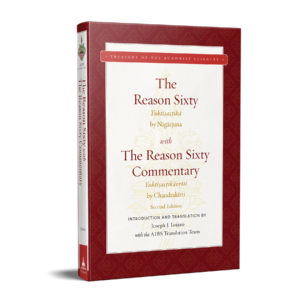 This volume contains English translations of two critical treatises of the Middle Way (Madhyamaka) Buddhist philosophical school: the Reason Sixty, by the most important of Indian thinkers Nāgārjuna (2nd century CE), and the commentary by his most influential successor, Chandrakīrti (7th century CE). These two treatises emphasize the non-foundationalist reasoning for which Madhyamaka thought is famed, here within the context of that quintessential Buddhist topic, universal compassion, thereby illuminating the nondual nature of these two fundamental components of Indian Buddhist thought. The full import of Nāgārjuna’s verses are brought to life by Chandrakīrti, whose influence in Tibetan Buddhist educational institutions remains profound to the present. Translator Joseph Loizzo, a Harvard-trained psychiatrist and Columbia-trained Buddhologist, elucidates the relevance of these two treatises to the linguistic turn in contemporary philosophy and emphasizes their practical, therapeutic possibilities. Comparing in particular the deep resonances between Chandrakīrti’s commentary and Wittgenstein’s later work, Loizzo presents a masterful analysis in cross-cultural thought that highlights the transformative potential of philosophy.
This volume contains English translations of two critical treatises of the Middle Way (Madhyamaka) Buddhist philosophical school: the Reason Sixty, by the most important of Indian thinkers Nāgārjuna (2nd century CE), and the commentary by his most influential successor, Chandrakīrti (7th century CE). These two treatises emphasize the non-foundationalist reasoning for which Madhyamaka thought is famed, here within the context of that quintessential Buddhist topic, universal compassion, thereby illuminating the nondual nature of these two fundamental components of Indian Buddhist thought. The full import of Nāgārjuna’s verses are brought to life by Chandrakīrti, whose influence in Tibetan Buddhist educational institutions remains profound to the present. Translator Joseph Loizzo, a Harvard-trained psychiatrist and Columbia-trained Buddhologist, elucidates the relevance of these two treatises to the linguistic turn in contemporary philosophy and emphasizes their practical, therapeutic possibilities. Comparing in particular the deep resonances between Chandrakīrti’s commentary and Wittgenstein’s later work, Loizzo presents a masterful analysis in cross-cultural thought that highlights the transformative potential of philosophy.
THE TRANSLATED SCRIPTURES & TREATISES
Maroon Volumes
The founding series from AIBS, fulfilling its mission to translate the Tengyur, the Tibetan canon of scientific treatises (śāstra), which constitutes Indo-Tibetan civilization’s contribution to the contemporary arts and sciences. Click to view the collection.
LATEST RELEASES
The Kālachakra Mandala: The Jonang Tradition
By Edward Henning
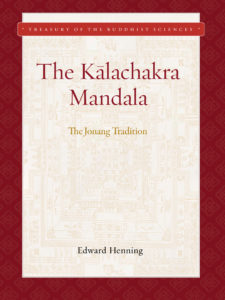 This volume contains an extensive analysis of the construction and symbolism of the mandala of the Kālachakra tantric system, the most intricate of the Buddhist unexcelled yoga tantras, the most advanced teachings within the Indo-Tibetan tradition. Indo-Tibetan tantric traditions depend on imagery and visualization for the processes of purifying cyclic existence, and Kālachakra is the most detailed. The late Edward Henning, one of the earliest Western specialists on this material, offers this labor of love as a testament to the genius of the Tibetan tradition in preserving and transmitting these teachings over a thousand years. Well known due to the Dalai Lama’s many public initiations, the Kālachakra mandala serves as a primary focal point for meditators both new and seasoned. Henning draws primarily from the Jonang tradition of Kālachakra practice to elucidate and clarify inconsistencies across traditions and literature regarding the construction and visualization of the three-tiered mandala with its hundreds of deities. In addition to providing detailed information on the images to be visualized, Henning provides in the final chapter a clear and extensive explanation of the symbolism of the habitat and inhabitants that are to be animated during the meditation session. An excellent companion to the translations of the Kālachakra Tantra and Stainless Light chapters co-published by the American Institute of Buddhist Studies and Wisdom Publications, this beautifully illustrated volume is a must-have for scholars and practitioners alike.
This volume contains an extensive analysis of the construction and symbolism of the mandala of the Kālachakra tantric system, the most intricate of the Buddhist unexcelled yoga tantras, the most advanced teachings within the Indo-Tibetan tradition. Indo-Tibetan tantric traditions depend on imagery and visualization for the processes of purifying cyclic existence, and Kālachakra is the most detailed. The late Edward Henning, one of the earliest Western specialists on this material, offers this labor of love as a testament to the genius of the Tibetan tradition in preserving and transmitting these teachings over a thousand years. Well known due to the Dalai Lama’s many public initiations, the Kālachakra mandala serves as a primary focal point for meditators both new and seasoned. Henning draws primarily from the Jonang tradition of Kālachakra practice to elucidate and clarify inconsistencies across traditions and literature regarding the construction and visualization of the three-tiered mandala with its hundreds of deities. In addition to providing detailed information on the images to be visualized, Henning provides in the final chapter a clear and extensive explanation of the symbolism of the habitat and inhabitants that are to be animated during the meditation session. An excellent companion to the translations of the Kālachakra Tantra and Stainless Light chapters co-published by the American Institute of Buddhist Studies and Wisdom Publications, this beautifully illustrated volume is a must-have for scholars and practitioners alike.
Buddhapālita’s Commentary on Nāgārjuna’s Middle Way
Buddhapālita
Introduced and Translated by Ian James Coghlan
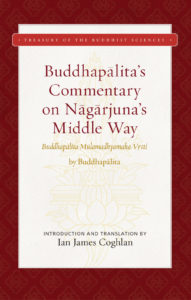 This “Buddhapālita” commentary on Nāgārjuna’s famous first-century text Wisdom: Fundamental Middle Way Verses has been considered for over a thousand years by Indian and Tibetan philosophers to be the special key that best unlocks the deep philosophical freedom from confusion and perplexity that the Middle Way (or Centrist) school seeks to provide for its students.
This “Buddhapālita” commentary on Nāgārjuna’s famous first-century text Wisdom: Fundamental Middle Way Verses has been considered for over a thousand years by Indian and Tibetan philosophers to be the special key that best unlocks the deep philosophical freedom from confusion and perplexity that the Middle Way (or Centrist) school seeks to provide for its students.
Chandrakīrti (seventh century) defended Buddhapālita’s elegant approach as most effective in opening the Middle Way for the inquiring mind to find the liberating experience of reality. Atisha (eleventh century) brought Buddhapālita’s and Chandrakīrti’s transformative critical method to spread widely in Tibet, and Tsongkhapa (fifteenth century) provided a clarification of this philosophical work that was so rigorous and crystal clear that it opened the minds of Tibetan philosopher scientists of all schools until today.
Ian Coghlan’s masterful translation makes Buddhapālita’s breakthrough elucidation of the Wisdom Verses clearly accessible. The translator’s unique education combines the Indo-Tibetan geshé curriculum with the modern doctoral training that adds comparative text-critical analysis and comparative language research in Sanskrit as well as Tibetan. This intellectual and experiential education enabled him to produce this reliable translation for the philosophical seeker to fully engage with Buddhapālita’s richly transformative, liberating work.
ASSOCIATED LITERATURE
Saffron Volumes
The Tibetan scholar-practitioner tradition’s literature is an immense treasury of insightful analytic and instructional works on the scriptures and scientific treatises of the Buddhist canon. This series is devoted to that literature, the basis of a still vibrant curriculum of teaching and experiential practice.
LATEST RELEASE
THE SUBLIME CONTINUUM AND ITS EXPLANATORY COMMENTARY
With the Sublime Continuum Supercommentary
By Bo Jiang
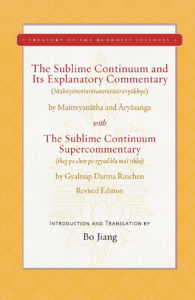 The original Sublime Continuum Explanatory Commentary was written by Noble Asanga to explain the verses received from the bodhisattva Maitreya in the late fourth century CE in northern India. Here it is introduced and presented in an original translation from Sanskrit and Tibetan, with the translation of an extensive Tibetan Supercommentary by Gyaltsap Darma Rinchen (1364–1432), whose work closely followed the view of his teacher, Tsong Khapa (1357–1419).
The original Sublime Continuum Explanatory Commentary was written by Noble Asanga to explain the verses received from the bodhisattva Maitreya in the late fourth century CE in northern India. Here it is introduced and presented in an original translation from Sanskrit and Tibetan, with the translation of an extensive Tibetan Supercommentary by Gyaltsap Darma Rinchen (1364–1432), whose work closely followed the view of his teacher, Tsong Khapa (1357–1419).
Contemporary scholars have widely misunderstood the Buddhist Centrist (Madhyamaka) teaching of emptiness, or selflessness, as either a form of nihilism or a radical skepticism. Yet Buddhist philosophers from Nagarjuna on have shown that the negation of intrinsic reality, when accurately understood, affirms the supreme value of relative realities. Gyaltsap Darma Rinchen, in his Supercommentary, elucidates a highly positive theory of buddha nature, showing how the wisdom of emptiness empowers the compassionate life of the enlightened, as it is touched by its oneness with the truth body of all buddhas. With his clear study of Gyaltsap’s insight and his original English translation, Bo Jiang completes his historic project of studying and presenting these works from Sanskrit and Tibetan in both Chinese and, now, English translations, in linked publications.
BRILLIANTLY ILLUMINATING LAMP OF THE FIVE STAGES:
Practical Instruction in the King of Tantras, The Glorious Esoteric Community
By Tsong Khapa Losang Drakpa
Introduced and Translation by Robert A.F. Thurman
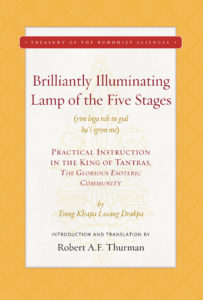 The Brilliantly Illuminating Lamp of the Five Stages (rim lnga rab tu gsal ba’i sgron me) is Tsong Khapa’s master commentary on the perfection-stage practices of the Esoteric Community (Guhyasamāja), the tantra he considered fundamental for the “father tantra” class of unexcelled yoga tantras, as the primary source for the development of the “magic body” technique for attaining buddhahood. Based on Nāgārjuna’s Five Stages (Pañcakrama) and Āryadeva’s Lamp That Integrates the Practices (Caryāmelāpakapradīpa), as well as a vast range of other works by Indian and Tibetan scholars and adepts, it also reveals openly the experiences of the author, himself a master practitioner.
The Brilliantly Illuminating Lamp of the Five Stages (rim lnga rab tu gsal ba’i sgron me) is Tsong Khapa’s master commentary on the perfection-stage practices of the Esoteric Community (Guhyasamāja), the tantra he considered fundamental for the “father tantra” class of unexcelled yoga tantras, as the primary source for the development of the “magic body” technique for attaining buddhahood. Based on Nāgārjuna’s Five Stages (Pañcakrama) and Āryadeva’s Lamp That Integrates the Practices (Caryāmelāpakapradīpa), as well as a vast range of other works by Indian and Tibetan scholars and adepts, it also reveals openly the experiences of the author, himself a master practitioner.
This blockbuster work of Jey Tsong Khapa opens a window on one of the most amazing, incredibly advanced attainments ever claimed to be possible for a human being within a single lifetime. The author explains in detail the relation between exoteric and esoteric teachings and practices on the path to complete enlightenment, with its seemingly superhuman awarenesses and abilities. He clarifies the interconnections between the various categories of secret tantras, inspires by showing how far-reaching are the systematic methods of positive personal transformation developed and taught in India and Tibet, and openly shows what this tradition considered possible, giving us a whole new vision of life’s meaning and a strengthened confidence in our horizon of opportunities. This bold and well-reasoned work presents a fascinating new way to understand our own body and mind, to manage more confidently our own life and death trajectories, and to rejoice in the sense of the extreme value of our human lifetime as a platform for realizing our personal evolutionary potential.
MEET THE EDITORS
Robert A.F. Thurman (Ari Genyen Tenzin Chotrag)
Editor-in-Chief, Treasury of the Buddhist Sciences
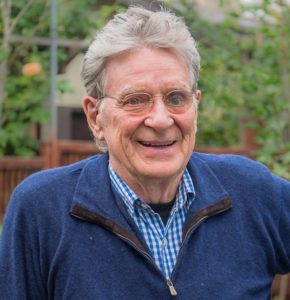 Robert Thurman is an American Buddhist author and academic who has written, edited, and translated several books on Tibetan Buddhism. He was the Je Tsongkhapa Professor of Indo-Tibetan Buddhist Studies at Columbia University, before retiring in June 2019. He held the first endowed chair in Buddhist Studies in the West. After education at Philips Exeter and Harvard, he studied Tibet and Tibetan Buddhism for almost thirty years as a personal student of His Holiness the Dalai Lama. He has written both scholarly and popular books, and has lectured widely all over the world. As President of the American Institute for Buddhist Studies, he convened the First Inner Science Conference with His Holiness the Dalai Lama at Amherst College in 1984. He is also a founding trustee of Tibet House New York.
Robert Thurman is an American Buddhist author and academic who has written, edited, and translated several books on Tibetan Buddhism. He was the Je Tsongkhapa Professor of Indo-Tibetan Buddhist Studies at Columbia University, before retiring in June 2019. He held the first endowed chair in Buddhist Studies in the West. After education at Philips Exeter and Harvard, he studied Tibet and Tibetan Buddhism for almost thirty years as a personal student of His Holiness the Dalai Lama. He has written both scholarly and popular books, and has lectured widely all over the world. As President of the American Institute for Buddhist Studies, he convened the First Inner Science Conference with His Holiness the Dalai Lama at Amherst College in 1984. He is also a founding trustee of Tibet House New York.
Thomas F. Yarnall
Executive Editor, Treasury of the Buddhist Sciences
![]() Thomas Yarnall is an Associate Research Scholar in the Department of Religion at Columbia University.
Thomas Yarnall is an Associate Research Scholar in the Department of Religion at Columbia University.
Series Committee:
Daniel Aitken, David Kittelstrom, Tim McNeill, Robert A.F. Thurman, Christian K. Wedemeyer, Thomas F. Yarnall
Editorial Board:
Ryuichi Ab., Jay Garfield, David Gray, Laura Harrington, Thupten Jinpa, Joseph Loizzo, Gary Tubb, Vesna Wallace, Christian Wedemeyer, Chun-fang Yu


